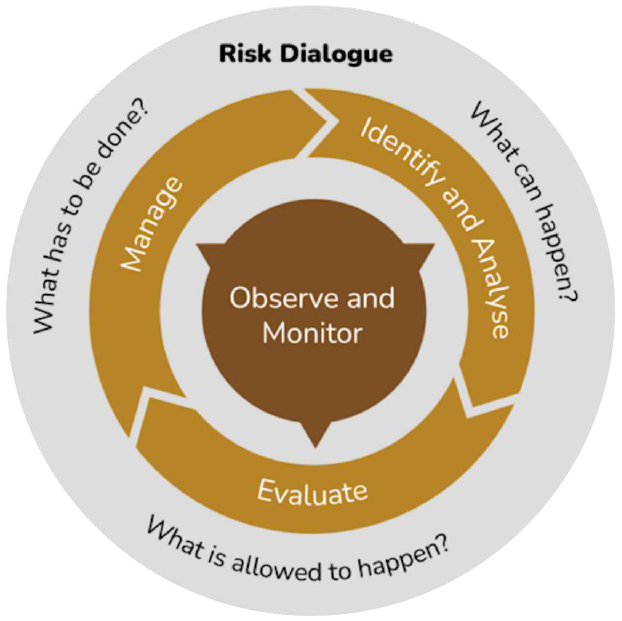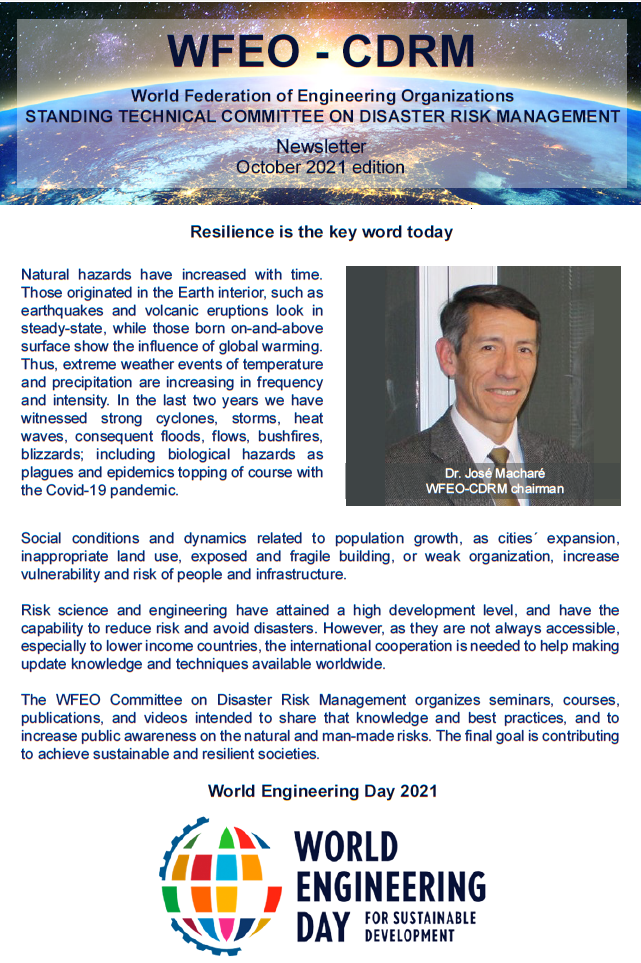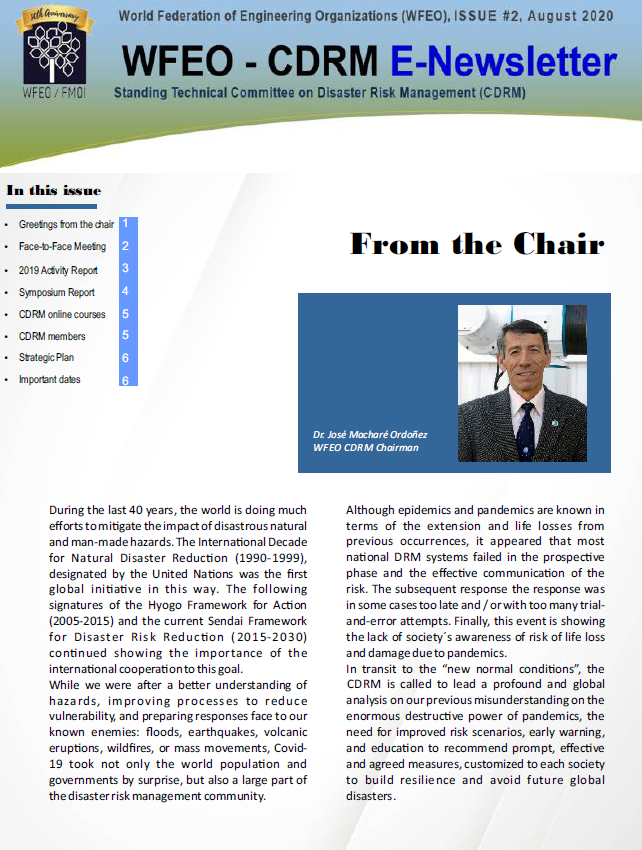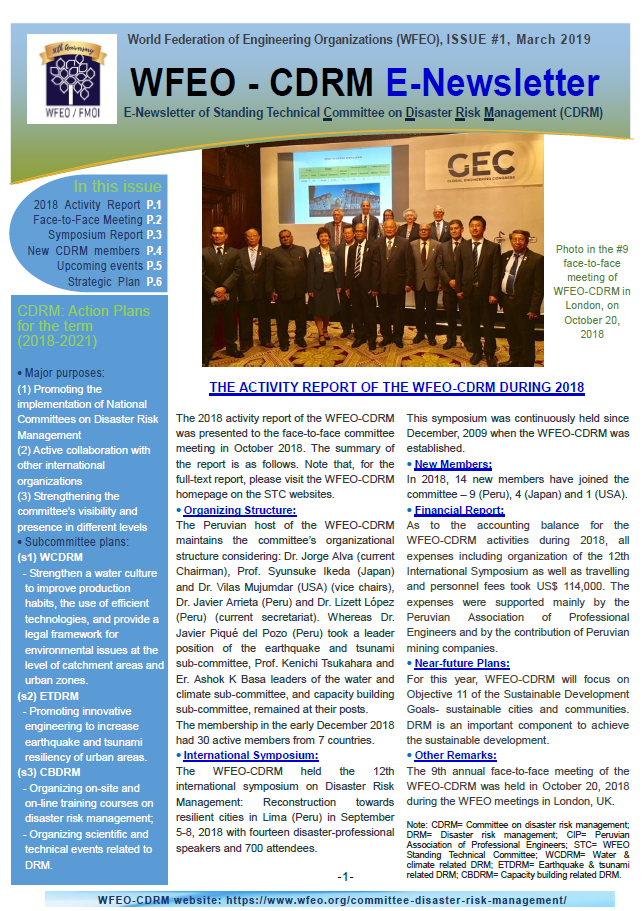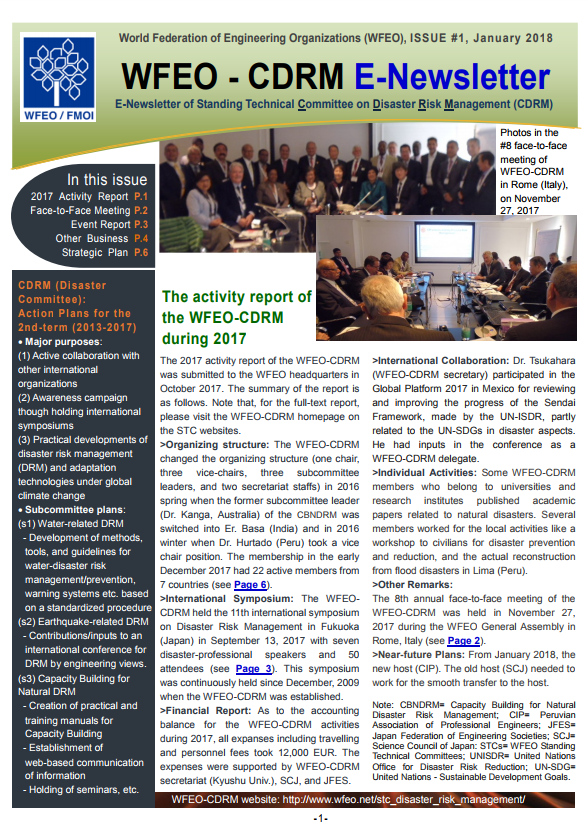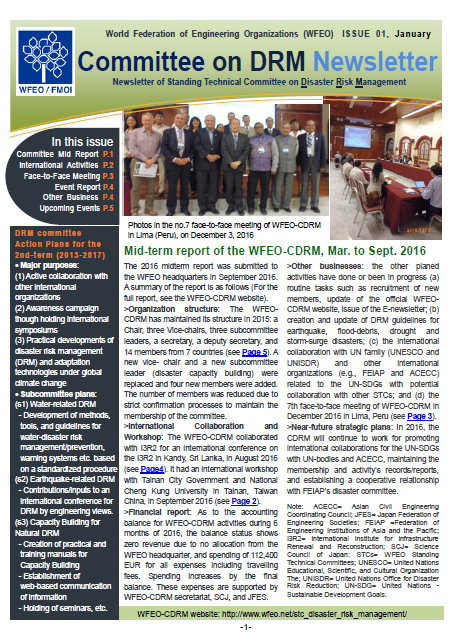
The WFEO-CDRM 2025-2029 will be hosted by the Swiss National Committee WFEO-ENGINEERS EUROPE, of which the Swiss Society of Engineers and Architects (SIA) in Zurich, Switzerland is a member. The SIA will be responsible for managing the CDRM.
Background
The Committee on Disaster Risk Management (CDRM) was established at the WFEO General Assembly held in December 2009, Kuwait, having as role minimizing the potential damage and risk to human life and damage through the proper application of technology.
Science Council of Japan (SCJ) and the Japan Federation of Engineering Societies (JFES) served as host of the Committee on Disaster Risk Management (CDRM), for an eight-year term from 2009 to 2017. The CDRM was formally transferred from Japan to Peru during the WFEO General Assembly, in December 2017. The Peruvian Engineers Association (CIP) served as host of the CDRM from 2018 to 2025.
Strategic Objectives
The WFEO-CDRM shall support the WFEO and the engineering profession worldwide by:
- Support through engineering, the implementation of the global initiative: Sendai Framework for Disaster Risk Reduction 2015-2030, four priority areas:
- Understanding disaster risk;
- Strengthening disaster risk governance to manage disaster risk;
- Investing in disaster risk reduction for resilience;
- Enhancing disaster preparedness for effective response and to “Build Back Better” in recovery, rehabilitation and reconstruction.
- Promote and assist in the achievement of the 2015-2030 U.N. Sustainable Development Goals, with primary focus on the following goals:
- Goal 11 – Sustainable cities and communities: Make cities and human settlements inclusive, safe, resilient and sustainable.
- Goal 13 – Climate Action: Take urgent action to combat climate change and its impacts.
- Goal 15 – Life on Land: Protect, restore and promote sustainable use of terrestrial ecosystems, sustainably manage forests, combat desertification, and halt and reverse land degradation and halt biodiversity loss.
- Strengthen the committee’s visibility and presence in the public sector, academic institutions, and multilateral organizations.
- Contribute to build the knowledge of disaster risk management practices for engineers and community leaders to increase resilience.
Strategic Actions
The strategic objectives will be reached through the following strategic actions. These actions will have global, regional or national scope. They will be organized within the five CDRM specialized working groups.
- Organize webinars, workshops and round tables to analyse specific issues of the DRM and reach clear outcomes;
- Publish the results, conclusions and recommendations of the activities mentioned above, as outreach material intended to policy makers, community leaders and academic institutions.
WFEO Vision
To be the acknowledged global leader of the engineering profession.
WFEO Mission
To be the unified voice of the engineering profession in providing strategic engineering guidance to global society for sustainable development.
CDRM Vision
To be an international organization to increase the resilience of cities and communities through engineering.
CDRM mission
To promote the culture of resilience and reduce disaster risk through the dissemination of knowledge and engaging in best engineering practices.
WFEO-CDRM 2025-2029
- Ensure and support the active participation of CDRM members in relevant policy and technical forums and committees to provide advice in their field of expertise;
- Organize and execute 6-8 Webinars annually on different DRM topics;
- Publish any publications and an annually activity report.
These actions require some support processes, namely:
- Strengthen communication links with relevant stakeholders to develop cooperative activities on DRM for sustainable development;
- Encourage and support CDRM vice-chairs to organize webinars, technical-scientific events, and publications related to their working groups;
- Encourage the WFEO national members to be part of this committee;
Who are we? – Introduction to the SIA
“Striving for a sustainable built environment designed for the future.”
The Swiss Society of Engineers and Architects (SIA) is the official professional association for qualified specialists in the fields of civil engineering, architecture, technology and the environment. With more than sixteen thousand members, the SIA forms a highly competent, interdisciplinary network whose central goal is to shape the living environment in a way that is fit for the future – entirely in the spirit of high-quality building culture.
The members are organised into 4 professional groups and 19 sections. The professional groups send a total of 38 delegates to the Assembly of Delegates, the supreme body of the SIA, in proportion to their membership. The remaining 38 of the 76 delegates are sent by the sections, with each section sending two delegates. The Assembly of Delegates decides on the most important business of the Society and appoints the Board, the highest governing body. The expert councils deal with the SIA’s core topics at a strategic level on behalf of the Board, the central commissions manage and are responsible for work on the growing body of SIA standards, and the Network Woman and SIA promotes gender equality and the advancement of women in the planning professions, as well as the “SIA international network”, which promotes international activities and cooperation. Numerous independently organised specialist associations have affiliated themselves to the SIA and work together on behalf of the planning profession. Through courses, conferences, lectures and field visits, they promote a mutual exchange of experience and nurture specialist contacts at national and international level. The Head Office coordinates, manages and supervises the day-to-day business in accordance with the Board’s guidelines and directives.
Quality and competence
The SIA stands for quality and professional competence, values that the Society has upheld and instilled throughout 180-plus years of activity. It is the key professional association for qualified experts in the construction, technology and environmental sectors. With over 16 000 members, the SIA constitutes an interdisciplinary network of professional groups, regional sections and specialist associations, as well as more than 200 expert and standardization committees. They strive in common for design innovation, integrity and sustainability as enduring hallmarks of construction in Switzerland.
Fostering fundamental values
Engineers, architects and professionals in allied sectors are the shapers of our built environment. In undertaking such work, they shoulder a major responsibility and have the Societyʼs vigorous support for tackling this challenge. The SIA obliges members to orient their professional activities towards sustainability, to pursue an exemplary ethical approach to the practice of their profession, and to respect rules of fair competition. The Societyʼs work acknowledges Switzerlandʼs regional, cultural and linguistic diversity. The SIA supports continuous further training for members and strives for a high level of education with international recognition.
Responsibility
The SIA operates through its members and stands by them. Members are active ambassadors of the Society’s ideas, which they implement in professional practice. The SIA represents their interests and champions the cultural, social and economic significance of their respective professions. The Society and its membership jointly shoulder a major responsibility and commitment to fine building culture.
Essential professional tools
The SIA maintains a body of standards that provide recognized, widely applied and indispensable regulations for planning and construction in Switzerland. The Society continuously reviews, revises and updates its standards and supplies information about their application. The standards and corresponding technical booklets and documentation are a joint effort by SIA experts, construction clients, contractors, suppliers and public authorities, along with universities and colleges.
Interdisciplinary cooperation
Todayʼs planning and construction projects are subject to constant change brought on by rapid technological developments and ever-growing ecological, social and economic challenges. It is an SIA conviction that the futureʼs problems are best solved through effective, professional, interdisciplinary partnerships. The Societyʼs four professional groups – Architecture, Civil Engineering, Technology, Environment – as well as its specialist associations, committees and regional sections collectively ensure that cooperation transcends disciplinary, cultural and generational boundaries.
Professionalism
The SIA stands for quality and professional competence. Members serve their clients as creators of comprehensive, innovative solutions guided throughout by responsibility, sustainability and outstanding quality.
The SIA knowledge network
The SIA represents its members and is supported by them. With this two-way commitment, the Society has achieved much regarding quality in the planning and construction sectors. SIA experts generally work on a volunteer basis in the committees, specialist associations, regional sections, professional groups, and in the Societyʼs other bodies. This approach has created an interdisciplinary knowledge network that lays a sound and broad-based foundation for the SIA and facilitates major contributions both present and future towards a sustainable, high-quality built environment designed for the times ahead.
The expertise of the SIA in the field of Disaster Risk Management (DRM)
In the field of natural hazards, the SIA supports professionals with the expertise of its members and numerous documents (standards, position papers, projects) that ensure the correct application of construction measures or land-use planning, all based on the integrated risk management matrix. In addition, the SIA collaborates with several associations and groups specialising in this field (FAN, Davos Baukultur, SLF, PLANAT, etc.) in order to support and assist public authorities in their search for optimal and sustainable solutions.
